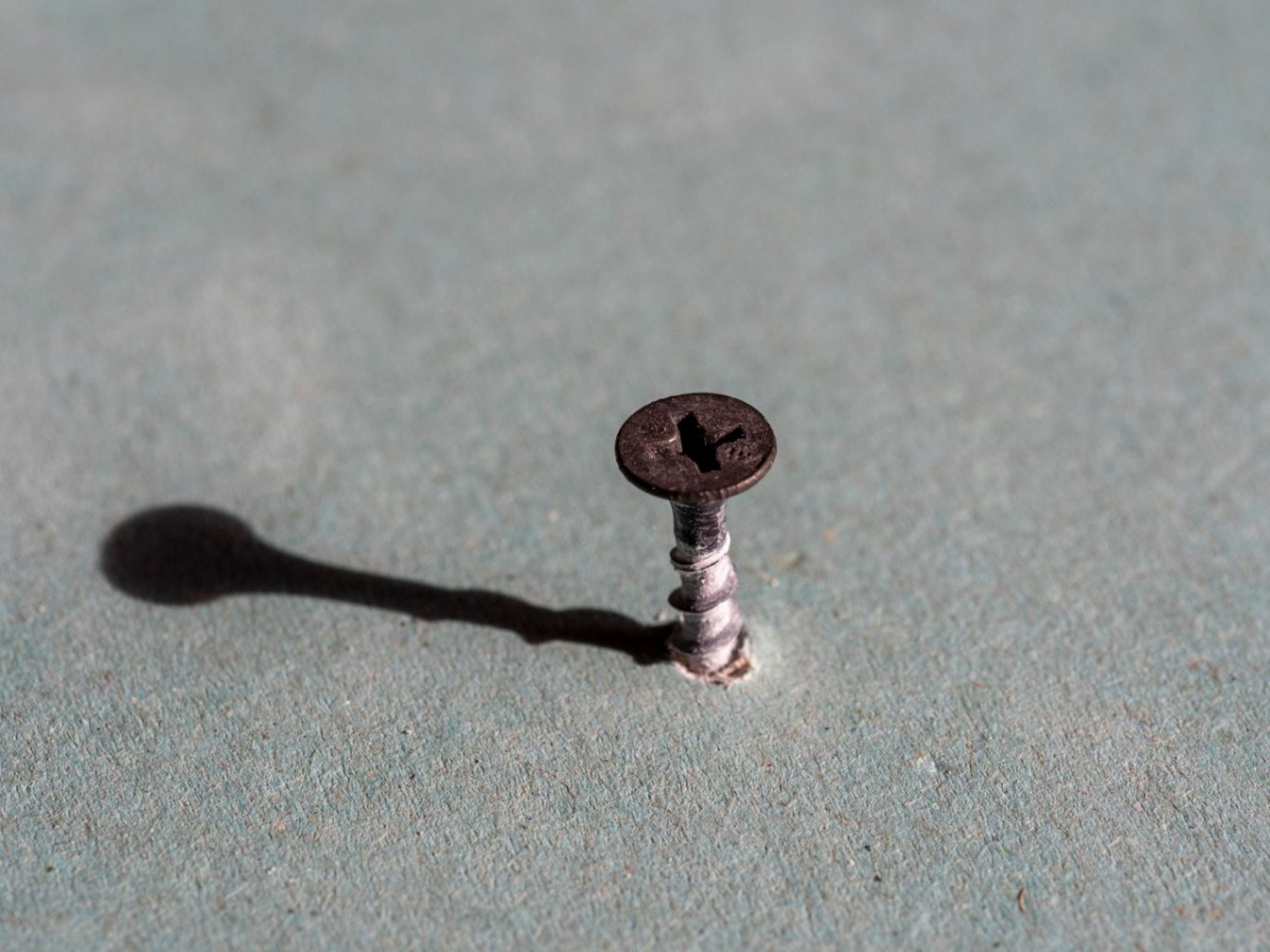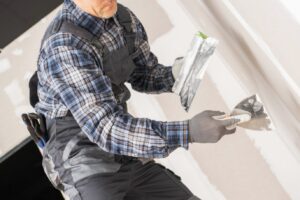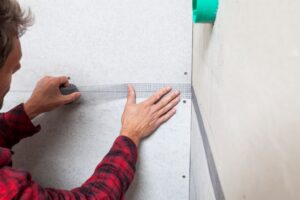This issue usually comes from improper installation, environmental changes, or structural movement. These factors can cause screws to loosen over time and damage your walls. Thankfully, there are simple ways to fix this problem for good. First, let’s understand what causes it. Then we’ll go over how to fix it and prevent it from happening again.
Key Takeaways
- Using the wrong screw type or driving screws too deep can cause them to pop.
- Moisture changes make drywall expand and contract, loosening screws.
- House settling or shifting can pull screws out of the wall.
- Keep indoor humidity between 30–50% to protect drywall.
- Replace popped screws at a slight angle so they stay in place better.
Understanding Drywall and Its Components
Drywall is made of gypsum between two layers of paper. To install it correctly, you need to use the right screws:
- Coarse-thread screws are best for wood studs.
- Fine-thread screws are better for metal studs.
If you’re using thicker drywall, use longer screws so they grip well. These tips help you avoid common installation problems that lead to screw popping.
Common Causes of Popping Drywall Screws
Screws often pop because of one (or more) of these issues:
- Poor installation techniques
- Moisture and humidity changes
- Structural movement
Fixing the root cause early can save you money and keep your walls looking great.
Improper Installation Techniques
One of the biggest reasons screws pop is because of how they were installed.
- Using the wrong screw type (like coarse-thread on drywall) can make screws come loose.
- Driving screws too deep or not spacing them evenly also weakens their grip.
Quick tips:
- Use fine-thread drywall screws.
- Slightly countersink screws just below the surface—don’t crush the paper.
- Space them about 16 inches apart to spread out the weight.
Moisture and Humidity Issues
Too much moisture in the air can make drywall swell, then shrink, which loosens screws.
- Install moisture barriers in wet areas like bathrooms.
- Keep humidity between 30–50% indoors.
- Use a dehumidifier in high-humidity spaces.
Fix the moisture problem first, then replace or resecure the screws for a lasting solution.
Structural Movement Factors
When a house settles or shifts, it can cause screws to pop.
- If the foundation isn’t stable, it puts stress on the drywall.
- Earthquakes or even small tremors can make this worse.
What helps:
- Keep your foundation in good shape.
- Use longer screws or ones made to handle movement.
- Add extra supports to the drywall if needed.
Poor Installation Techniques (Again)
Another common problem: installing screws too close to edges or too far apart.
- This weakens their hold.
- Using screws that are too short can also be a problem.
Make sure to:
- Use the right length screws for your drywall type.
- Keep screws 16 inches apart on studs.
- Drive screws just below the surface.
Moisture and Humidity Issues (Again)
Leaky pipes, poor ventilation, or just too much humidity can loosen screws.
Excessive Moisture Sources
- Leaks from plumbing or roofs
- Bad ventilation in kitchens or bathrooms
Use a moisture meter to find hidden leaks. Fix the source, then regulate moisture levels.
Humidity Control Solutions
- Use a dehumidifier.
- Keep air flowing with fans.
- Seal gaps around windows and doors.
- Use exhaust fans in steamy areas.
- Check levels with a hygrometer—stay between 30–50%.
Structural Movement and Settling
Shifting foundations can pull on screws and push them out.
- Look for cracks in walls or uneven floors.
- Fix drainage issues around your home.
Use longer screws and drywall adhesive to hold better. These changes keep your drywall secure.
The Role of Temperature Changes
Changes in temperature make drywall and framing materials expand and contract. This causes stress on screws.
Thermal Expansion Effects
- If your insulation is poor, your drywall will move more with temperature changes.
- This movement loosens screws over time.
Install good insulation to keep temperatures stable. Use longer screws that allow for some movement.
Humidity Influence
- High humidity causes drywall to expand, loosening screws.
- Low humidity can dry it out and shrink it.
Use moisture-resistant drywall and corrosion-resistant screws. Keep air moving and fix any leaks quickly.
Seasonal Temperature Fluctuations
Hot summers and cold winters make drywall expand and contract.
- This pulls on screws and weakens their hold.
Keep indoor temps steady. Use insulation and screws made for drywall to minimize this problem.
Choosing the Right Screws and Fasteners
- Use coarse-thread screws for wood studs.
- Use fine-thread screws for metal studs.
- Galvanized screws resist rust—great for damp areas.
- Screws should go at least 1 inch into the stud.
Choosing the right hardware gives your drywall a stronger, longer-lasting hold.
How to Properly Reinstall Popping Screws
- Remove the loose screw.
- Check for damage around the hole.
- Patch it with joint compound if needed.
- Use a longer screw and drive it in at a slight angle.
- Don’t overdrive it—just below the surface is enough.
- Cover with joint compound for a smooth finish.
This will stop the screw from popping again.
Preventative Measures to Avoid Future Issues
- Use the right screws.
- Drive them to the right depth.
- Check for early signs of wall movement.
- Reinforce joints with extra screws.
- Monitor humidity and temperature.
A little upkeep goes a long way in preventing future issues.
When to Call a Professional for Help
You should call a pro if:
- Screws keep popping out after you fix them.
- You see large cracks or bulges.
- There’s mold, water damage, or sagging drywall.
Pros can find the real cause and fix it properly. They’ll save you time and make sure your walls are secure.
Frequently Asked Questions
Can I reuse the same screw holes for repairs?
Yes, but fill and reinforce them first to keep them strong.
What tools do I need to fix popping screws?
A drill, screws, screwdriver, joint compound, and possibly drywall adhesive.
How can I tell if my drywall is damaged?
Look for discoloration, soft spots, or hollow sounds when tapped.
Are there specific screws for different drywall types?
Yes. Match the screw to the drywall and stud material for best results.
Will painting help prevent screws from popping out?
No. Paint hides the issue but doesn’t fix it. Make repairs before painting.
Conclusion
Fixing popping drywall screws starts with knowing the cause. Use the right screws, control humidity, and keep up with maintenance. If the issue keeps coming back, call a pro. These steps will help keep your drywall solid and smooth.




